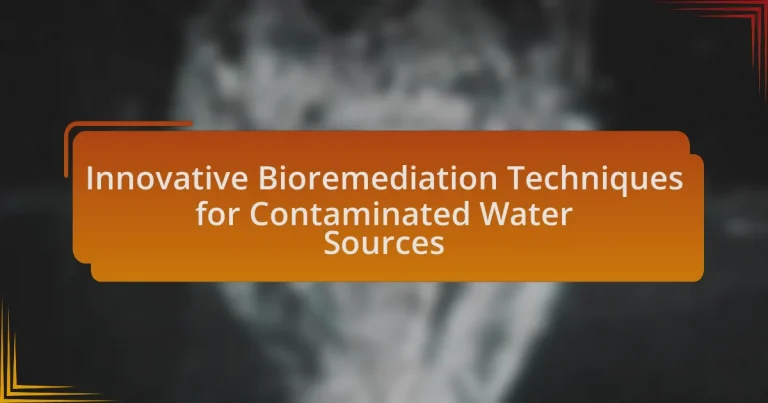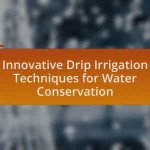Innovative bioremediation techniques for contaminated water sources utilize biological processes to effectively degrade pollutants, offering sustainable alternatives to traditional remediation methods. Key techniques include microbial fuel cells, phytoremediation, and bioaugmentation, which leverage microorganisms and plants to remove contaminants such as heavy metals and organic pollutants. These methods demonstrate significant advantages, including reduced environmental impact, lower operational costs, and enhanced efficiency in contaminant removal. The article also explores the principles behind these techniques, the types of contaminants they address, and the future trends in bioremediation, highlighting the role of technology and regulatory changes in shaping these practices.
What are Innovative Bioremediation Techniques for Contaminated Water Sources?
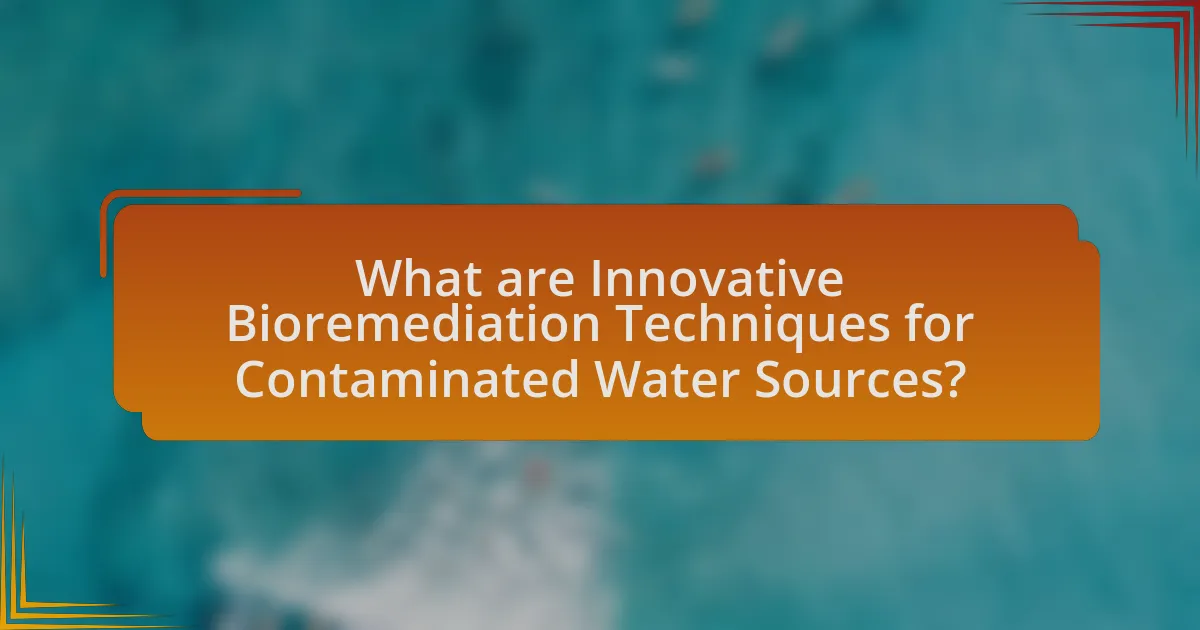
Innovative bioremediation techniques for contaminated water sources include the use of microbial fuel cells, phytoremediation, and bioaugmentation. Microbial fuel cells harness the metabolic processes of microorganisms to convert contaminants into energy while simultaneously treating wastewater. Phytoremediation employs plants to absorb, degrade, or stabilize pollutants, effectively using their natural processes to clean contaminated water. Bioaugmentation involves the addition of specific strains of microorganisms to enhance the degradation of pollutants, improving the efficiency of the bioremediation process. These techniques have been validated through various studies, demonstrating their effectiveness in reducing contaminants such as heavy metals, hydrocarbons, and nutrients in water sources.
How do these techniques differ from traditional methods?
Innovative bioremediation techniques differ from traditional methods primarily in their use of biological processes to degrade contaminants more efficiently and sustainably. Traditional methods often rely on physical or chemical treatments, such as filtration or chemical oxidation, which can be costly and may produce secondary pollutants. In contrast, innovative techniques utilize microorganisms or plants to naturally break down pollutants, leading to less environmental disruption and lower operational costs. For example, studies have shown that phytoremediation can reduce heavy metal concentrations in contaminated water by up to 90%, demonstrating the effectiveness of biological approaches over conventional methods.
What are the key principles behind innovative bioremediation?
The key principles behind innovative bioremediation include the use of microorganisms to degrade pollutants, the enhancement of natural attenuation processes, and the application of bioaugmentation techniques. Microorganisms, such as bacteria and fungi, are capable of breaking down hazardous substances into less harmful forms, which is fundamental to bioremediation. Enhancing natural attenuation involves optimizing environmental conditions to promote the growth of indigenous microbial populations that can effectively degrade contaminants. Bioaugmentation introduces specific strains of microorganisms to contaminated sites to improve degradation rates. These principles are supported by numerous studies demonstrating the effectiveness of bioremediation in reducing contaminants in various environments, such as the successful use of Pseudomonas species in degrading petroleum hydrocarbons in soil and water.
How do these techniques utilize natural processes?
Innovative bioremediation techniques utilize natural processes by harnessing microorganisms and plants to degrade or remove contaminants from water sources. These techniques often involve the stimulation of native microbial populations or the introduction of specific strains that can metabolize pollutants, such as hydrocarbons or heavy metals, effectively converting them into less harmful substances. For instance, phytoremediation employs plants to absorb, accumulate, and detoxify contaminants through natural biological processes, demonstrating the effectiveness of leveraging ecological systems for environmental cleanup.
What types of contaminants can be addressed by these techniques?
Innovative bioremediation techniques can address a variety of contaminants, including heavy metals, organic pollutants, and pathogens. Heavy metals such as lead, mercury, and cadmium can be effectively removed through microbial processes that transform these toxic substances into less harmful forms. Organic pollutants, including hydrocarbons and pesticides, are degraded by specific microorganisms that utilize these compounds as energy sources. Additionally, pathogens like bacteria and viruses can be reduced through bioremediation methods that enhance the natural microbial community, promoting the breakdown of harmful organisms. These techniques have been validated in numerous studies, demonstrating their effectiveness in restoring contaminated water sources.
Which organic pollutants are effectively treated?
Organic pollutants that are effectively treated include polycyclic aromatic hydrocarbons (PAHs), chlorinated solvents, and pesticides. These pollutants are commonly found in contaminated water sources and can be degraded by specific bioremediation techniques. For instance, research has shown that certain bacteria can metabolize PAHs, reducing their concentration in water. Additionally, bioremediation methods utilizing microorganisms have been successful in breaking down chlorinated solvents and various pesticides, demonstrating their effectiveness in treating these organic pollutants.
How do these techniques handle heavy metals and inorganic contaminants?
Innovative bioremediation techniques effectively manage heavy metals and inorganic contaminants through various biological processes. These techniques utilize microorganisms, such as bacteria and fungi, which can bioaccumulate, transform, or immobilize heavy metals, thereby reducing their toxicity and bioavailability in contaminated water. For instance, certain bacteria can convert toxic forms of metals into less harmful states, while others can absorb metals into their cellular structures, effectively removing them from the water column. Research has demonstrated that bioremediation can achieve significant reductions in heavy metal concentrations, with studies showing up to 90% removal efficiency in specific cases, highlighting the effectiveness of these biological methods in addressing inorganic contaminants.
What are the advantages of using innovative bioremediation techniques?
Innovative bioremediation techniques offer several advantages, including enhanced efficiency in degrading pollutants and reduced environmental impact. These techniques utilize advanced microbial processes or engineered organisms that can target specific contaminants more effectively than traditional methods. For instance, studies have shown that genetically modified microorganisms can significantly accelerate the breakdown of hazardous substances, such as heavy metals and organic pollutants, leading to faster restoration of contaminated sites. Additionally, innovative bioremediation methods often require less energy and fewer chemical inputs, making them more sustainable and cost-effective over time.
How do these techniques contribute to environmental sustainability?
Innovative bioremediation techniques contribute to environmental sustainability by effectively removing contaminants from water sources, thereby restoring ecosystem health. These techniques utilize microorganisms to degrade pollutants, which reduces the need for chemical treatments that can harm the environment. For instance, studies have shown that bioremediation can reduce heavy metal concentrations in contaminated water by up to 90%, significantly improving water quality and promoting biodiversity. Additionally, these methods often require less energy and resources compared to traditional remediation approaches, further minimizing their environmental footprint.
What economic benefits do they provide compared to traditional methods?
Innovative bioremediation techniques for contaminated water sources provide significant economic benefits compared to traditional methods by reducing cleanup costs and time. For instance, bioremediation often requires less energy and fewer chemical inputs, leading to lower operational expenses. A study published in the Journal of Environmental Management found that bioremediation can be up to 50% cheaper than conventional methods like excavation and landfill disposal. Additionally, these techniques can restore ecosystems more effectively, allowing for quicker reuse of contaminated sites, which further enhances economic viability.
How are innovative bioremediation techniques implemented in the field?
Innovative bioremediation techniques are implemented in the field through the application of microorganisms and plants to degrade or remove contaminants from water sources. These techniques often involve the use of engineered microbes that are specifically designed to metabolize pollutants, such as heavy metals or organic compounds, effectively breaking them down into less harmful substances. For instance, the use of genetically modified bacteria has been shown to enhance the degradation of petroleum hydrocarbons in contaminated water, as evidenced by studies demonstrating a significant reduction in pollutant levels within weeks of application. Additionally, phytoremediation, which utilizes plants to absorb and accumulate contaminants, has been successfully employed in various field trials, showcasing its effectiveness in reducing heavy metal concentrations in water bodies.
What challenges are faced during the application of these techniques?
The challenges faced during the application of innovative bioremediation techniques for contaminated water sources include variability in environmental conditions, the complexity of contaminant mixtures, and the potential for incomplete degradation of pollutants. Environmental conditions such as temperature, pH, and nutrient availability can significantly affect microbial activity and the overall effectiveness of bioremediation. Additionally, the presence of multiple contaminants can hinder the biodegradation process, as different microorganisms may be required to target specific pollutants. Studies have shown that some contaminants may resist degradation, leading to persistent environmental issues. For instance, research published in the journal “Environmental Science & Technology” highlights that certain heavy metals and synthetic organic compounds can inhibit microbial growth, complicating remediation efforts.
What are the specific methods used in Innovative Bioremediation?
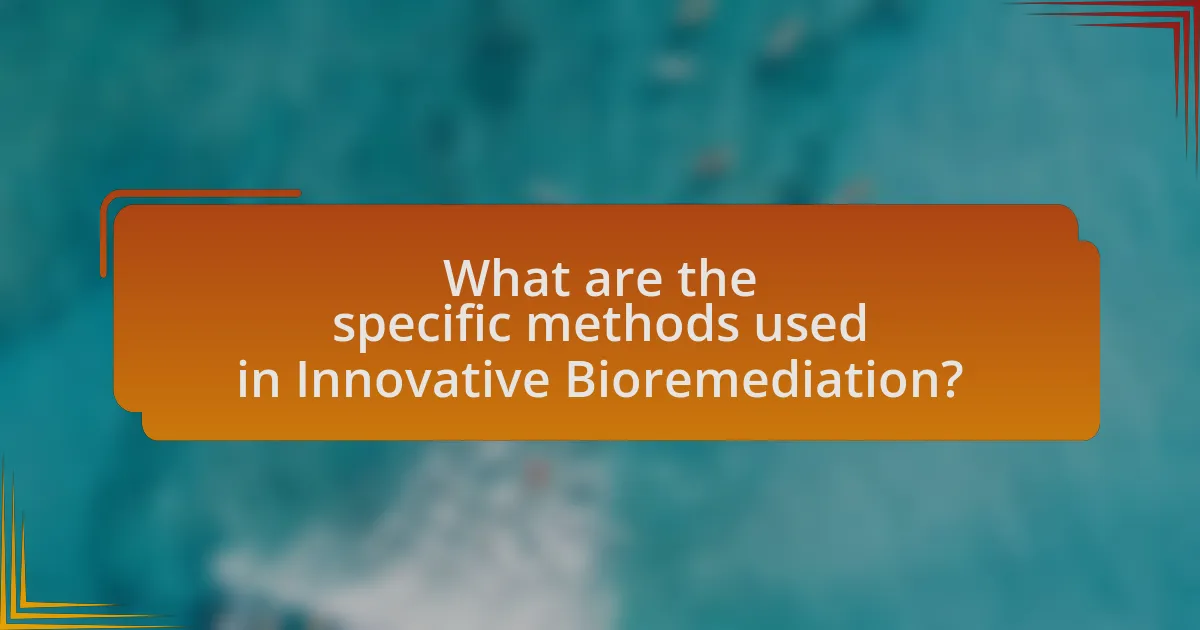
Innovative bioremediation employs several specific methods to address contaminated water sources, including bioaugmentation, biostimulation, phytoremediation, and constructed wetlands. Bioaugmentation involves the addition of specialized microorganisms to enhance the degradation of pollutants. Biostimulation enhances the growth of indigenous microorganisms by adding nutrients or electron donors, thereby accelerating the natural degradation processes. Phytoremediation utilizes plants to absorb, degrade, or stabilize contaminants in water. Constructed wetlands are engineered systems that mimic natural wetlands, using vegetation and soil to filter and treat contaminated water effectively. These methods have been validated through various studies demonstrating their effectiveness in reducing pollutants in contaminated environments.
How does phytoremediation work in treating contaminated water?
Phytoremediation treats contaminated water by utilizing plants to absorb, degrade, or stabilize pollutants. This process involves the uptake of contaminants through plant roots, which can then be stored in plant tissues or transformed into less harmful substances through metabolic processes. For instance, certain plants can effectively remove heavy metals, organic pollutants, and nutrients from water, thereby improving water quality. Research has shown that species like willow and poplar are particularly effective in phytoremediation due to their extensive root systems and high biomass production, which enhance contaminant uptake and degradation.
What types of plants are most effective in phytoremediation?
The types of plants most effective in phytoremediation include hyperaccumulators, such as sunflower (Helianthus annuus), Indian mustard (Brassica juncea), and certain species of willow (Salix spp.). These plants are capable of absorbing and accumulating heavy metals and other contaminants from soil and water. For instance, Indian mustard can extract lead and cadmium, while sunflowers have been shown to effectively remove uranium and other heavy metals from contaminated sites. Research has demonstrated that these plants can significantly reduce pollutant levels, making them valuable tools in the remediation of contaminated environments.
How do plants contribute to the breakdown of pollutants?
Plants contribute to the breakdown of pollutants through a process known as phytoremediation, where they absorb, accumulate, and detoxify contaminants from soil and water. This process involves various mechanisms, including uptake of heavy metals and organic pollutants through their roots, which are then either stored in plant tissues or transformed into less harmful substances through metabolic processes. For example, studies have shown that certain plant species, such as willows and poplars, can effectively remove heavy metals like lead and cadmium from contaminated sites, demonstrating their capability to mitigate pollution. Additionally, plants can enhance microbial activity in the rhizosphere, further promoting the degradation of organic pollutants.
What role do microorganisms play in bioremediation?
Microorganisms play a crucial role in bioremediation by degrading pollutants and contaminants in the environment. These microorganisms, including bacteria, fungi, and algae, possess metabolic pathways that enable them to break down hazardous substances such as heavy metals, petroleum hydrocarbons, and organic solvents into less harmful or non-toxic forms. For instance, certain bacteria can metabolize toluene and benzene, common components of oil spills, effectively reducing their concentration in contaminated water. Studies have shown that bioremediation can lead to significant reductions in pollutant levels; for example, a study published in the journal “Environmental Science & Technology” demonstrated that microbial degradation can remove up to 90% of petroleum hydrocarbons from contaminated sites within weeks. This ability to transform and detoxify harmful compounds makes microorganisms essential agents in the restoration of polluted environments.
How are specific microorganisms selected for bioremediation processes?
Specific microorganisms are selected for bioremediation processes based on their ability to degrade specific contaminants effectively. This selection process involves screening microorganisms from environmental samples for their metabolic capabilities, often using techniques such as enrichment culturing and molecular methods to identify those that can utilize pollutants as carbon or energy sources. For example, Pseudomonas species are frequently chosen for their versatility in degrading hydrocarbons, as demonstrated in studies showing their effectiveness in oil spill remediation.
What are the mechanisms through which microorganisms degrade contaminants?
Microorganisms degrade contaminants primarily through mechanisms such as biodegradation, biosorption, and bioaccumulation. Biodegradation involves the enzymatic breakdown of organic pollutants into less harmful substances, facilitated by specific microbial species that possess the necessary metabolic pathways. For instance, bacteria like Pseudomonas aeruginosa can degrade hydrocarbons, demonstrating their capability to metabolize complex organic compounds.
Biosorption refers to the passive uptake of contaminants by microbial cells, where the contaminants adhere to the cell surface, effectively removing them from the environment. This process is often utilized by fungi, which can absorb heavy metals and other pollutants through their cell walls.
Bioaccumulation occurs when microorganisms absorb and concentrate contaminants from their environment, leading to a higher internal concentration than that of the surrounding medium. This mechanism is particularly relevant for heavy metals, where certain bacteria can sequester metals like lead and mercury, reducing their bioavailability and toxicity in contaminated water sources.
These mechanisms collectively contribute to the effective bioremediation of contaminated environments, showcasing the vital role microorganisms play in environmental cleanup efforts.
How does bioaugmentation enhance bioremediation efforts?
Bioaugmentation enhances bioremediation efforts by introducing specific microorganisms that can degrade pollutants more effectively than native microbial populations. This process accelerates the breakdown of contaminants, such as hydrocarbons and heavy metals, by providing specialized metabolic pathways that may be absent in the indigenous microbial community. Studies have shown that bioaugmentation can significantly increase the rate of contaminant removal; for instance, a review published in “Environmental Science & Technology” by Zhang et al. (2020) demonstrated that bioaugmented systems achieved up to 90% reduction in pollutant concentrations within weeks, compared to traditional bioremediation methods.
What are the criteria for selecting microbial strains for bioaugmentation?
The criteria for selecting microbial strains for bioaugmentation include the strain’s ability to degrade specific contaminants, its growth rate in the target environment, and its tolerance to environmental stressors such as temperature, pH, and salinity. Additionally, the strain should exhibit a high level of metabolic versatility, allowing it to utilize various substrates, and should be non-pathogenic to ensure safety in application. Studies have shown that strains like Pseudomonas and Bacillus are often favored due to their proven effectiveness in degrading hydrocarbons and other pollutants, demonstrating their suitability for bioremediation efforts.
How does bioaugmentation improve the efficiency of contaminant removal?
Bioaugmentation improves the efficiency of contaminant removal by introducing specific microorganisms that enhance the degradation of pollutants in contaminated environments. These added microorganisms are often selected for their ability to metabolize particular contaminants, thereby increasing the overall rate of bioremediation. Studies have shown that bioaugmentation can lead to a significant reduction in contaminant concentrations; for example, research published in the journal “Environmental Science & Technology” demonstrated that bioaugmented systems achieved up to 90% removal of certain hydrocarbons within weeks, compared to traditional methods that were less effective. This targeted approach not only accelerates the breakdown of contaminants but also helps restore the ecological balance in affected areas.
What are the future trends in Innovative Bioremediation Techniques?
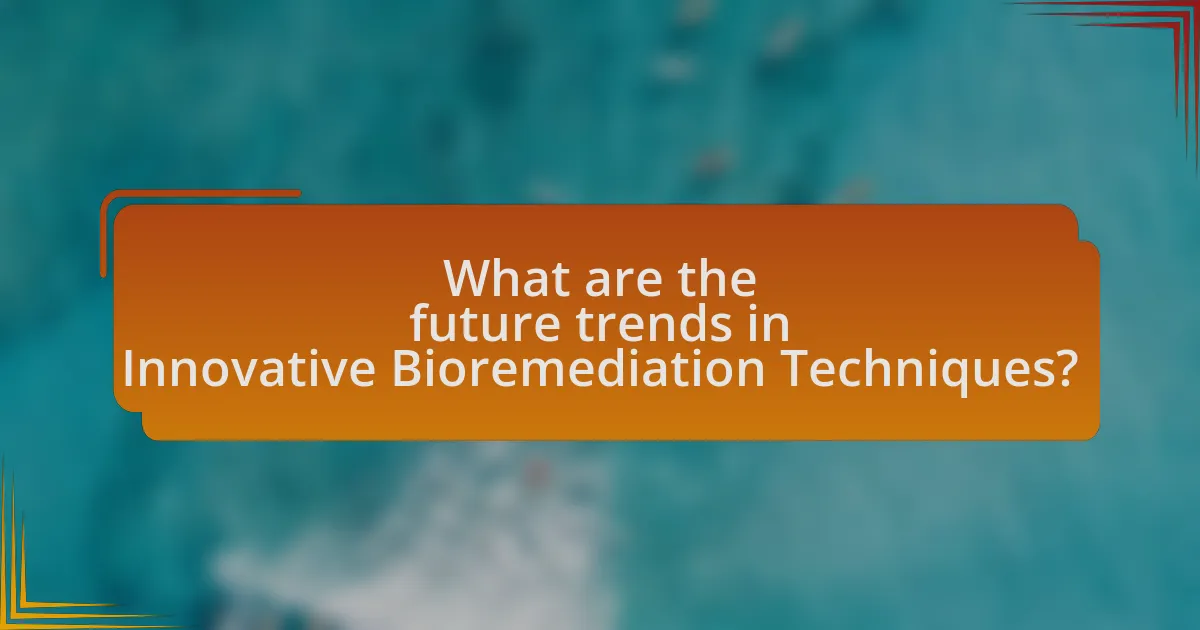
Future trends in innovative bioremediation techniques include the use of synthetic biology, nanotechnology, and microbial fuel cells. Synthetic biology enables the design of engineered microorganisms that can efficiently degrade pollutants, as demonstrated by research from the University of California, which developed bacteria capable of breaking down plastics. Nanotechnology enhances the delivery and effectiveness of bioremediation agents, with studies showing that nanoparticles can improve the bioavailability of contaminants for microbial degradation. Additionally, microbial fuel cells are being explored for their dual function of treating wastewater while generating electricity, as evidenced by research published in the journal Environmental Science & Technology, which highlights their potential in sustainable water management. These trends indicate a shift towards more efficient, cost-effective, and sustainable bioremediation solutions.
How is technology advancing bioremediation methods?
Technology is advancing bioremediation methods through the integration of genetic engineering, nanotechnology, and advanced monitoring systems. Genetic engineering allows for the development of microorganisms with enhanced capabilities to degrade pollutants, as demonstrated by the use of genetically modified bacteria that can metabolize toxic compounds more efficiently. Nanotechnology contributes by creating nanoparticles that can adsorb contaminants or deliver remediation agents directly to polluted sites, increasing the effectiveness of the treatment. Advanced monitoring systems, such as remote sensing and real-time data analytics, enable precise tracking of contaminant levels and the effectiveness of bioremediation efforts, ensuring timely interventions. These technological advancements collectively enhance the efficiency, speed, and effectiveness of bioremediation processes.
What role do nanotechnology and biotechnology play in future developments?
Nanotechnology and biotechnology are pivotal in advancing innovative bioremediation techniques for contaminated water sources. Nanotechnology enhances the efficiency of pollutant removal through the development of nanoscale materials that can target and degrade contaminants at a molecular level, significantly improving the speed and effectiveness of remediation processes. Biotechnology contributes by utilizing microorganisms and enzymes that can naturally break down pollutants, offering sustainable solutions for water treatment. For instance, specific engineered bacteria have been shown to degrade heavy metals and organic pollutants, demonstrating their potential in real-world applications. Together, these technologies are expected to revolutionize water purification methods, making them more efficient and environmentally friendly.
How can data analytics improve bioremediation strategies?
Data analytics can improve bioremediation strategies by enabling the identification of optimal microbial strains and environmental conditions for contaminant degradation. By analyzing large datasets from previous bioremediation projects, researchers can uncover patterns that indicate which microorganisms are most effective in specific environments, leading to more targeted and efficient remediation efforts. For instance, a study published in the journal “Environmental Science & Technology” demonstrated that machine learning algorithms could predict the performance of various microbial communities in degrading petroleum hydrocarbons, resulting in a 30% increase in remediation efficiency compared to traditional methods. This data-driven approach allows for real-time monitoring and adjustment of bioremediation processes, ultimately enhancing the effectiveness and speed of contaminant removal.
What are the potential regulatory changes affecting bioremediation?
Potential regulatory changes affecting bioremediation include stricter guidelines on the use of genetically modified organisms (GMOs) and enhanced monitoring requirements for bioremediation projects. The U.S. Environmental Protection Agency (EPA) has been considering updates to the National Pollutant Discharge Elimination System (NPDES) permits, which could impose more rigorous standards on effluent discharges from bioremediation processes. Additionally, the introduction of new legislation aimed at improving environmental protection may lead to increased liability for companies utilizing bioremediation techniques, necessitating more comprehensive risk assessments and documentation. These changes are driven by growing public concern over environmental safety and the effectiveness of bioremediation methods in addressing contamination issues.
How might environmental policies influence the adoption of innovative techniques?
Environmental policies can significantly influence the adoption of innovative techniques by creating regulatory frameworks that incentivize sustainable practices. For instance, policies that impose stricter pollution controls can drive industries to seek out and implement bioremediation techniques to meet compliance standards. A study by the Environmental Protection Agency indicates that companies adopting innovative technologies in response to regulatory pressures often experience reduced operational costs and improved environmental outcomes. This demonstrates that well-designed environmental policies not only encourage the development of new techniques but also facilitate their integration into existing practices.
What are the implications of stricter regulations on bioremediation practices?
Stricter regulations on bioremediation practices lead to enhanced environmental protection and increased operational costs for companies. These regulations ensure that bioremediation methods meet higher safety and efficacy standards, which can improve the overall effectiveness of contaminant removal from water sources. However, the financial burden on businesses may rise due to the need for compliance with more rigorous testing, monitoring, and reporting requirements. For instance, the U.S. Environmental Protection Agency (EPA) has established guidelines that necessitate comprehensive assessments of bioremediation technologies, which can increase project timelines and costs.
What best practices should be followed for successful bioremediation?
Successful bioremediation requires careful planning and execution, including site assessment, selection of appropriate microorganisms, and monitoring of environmental conditions. Conducting a thorough site assessment helps identify the type and extent of contamination, which informs the choice of bioremediation techniques. Selecting microorganisms that are naturally occurring or genetically engineered for specific contaminants enhances the effectiveness of the process. Additionally, monitoring environmental conditions such as pH, temperature, and nutrient availability ensures optimal conditions for microbial activity, which is crucial for achieving successful remediation outcomes. These practices are supported by studies indicating that tailored approaches significantly improve the efficiency of bioremediation efforts.
